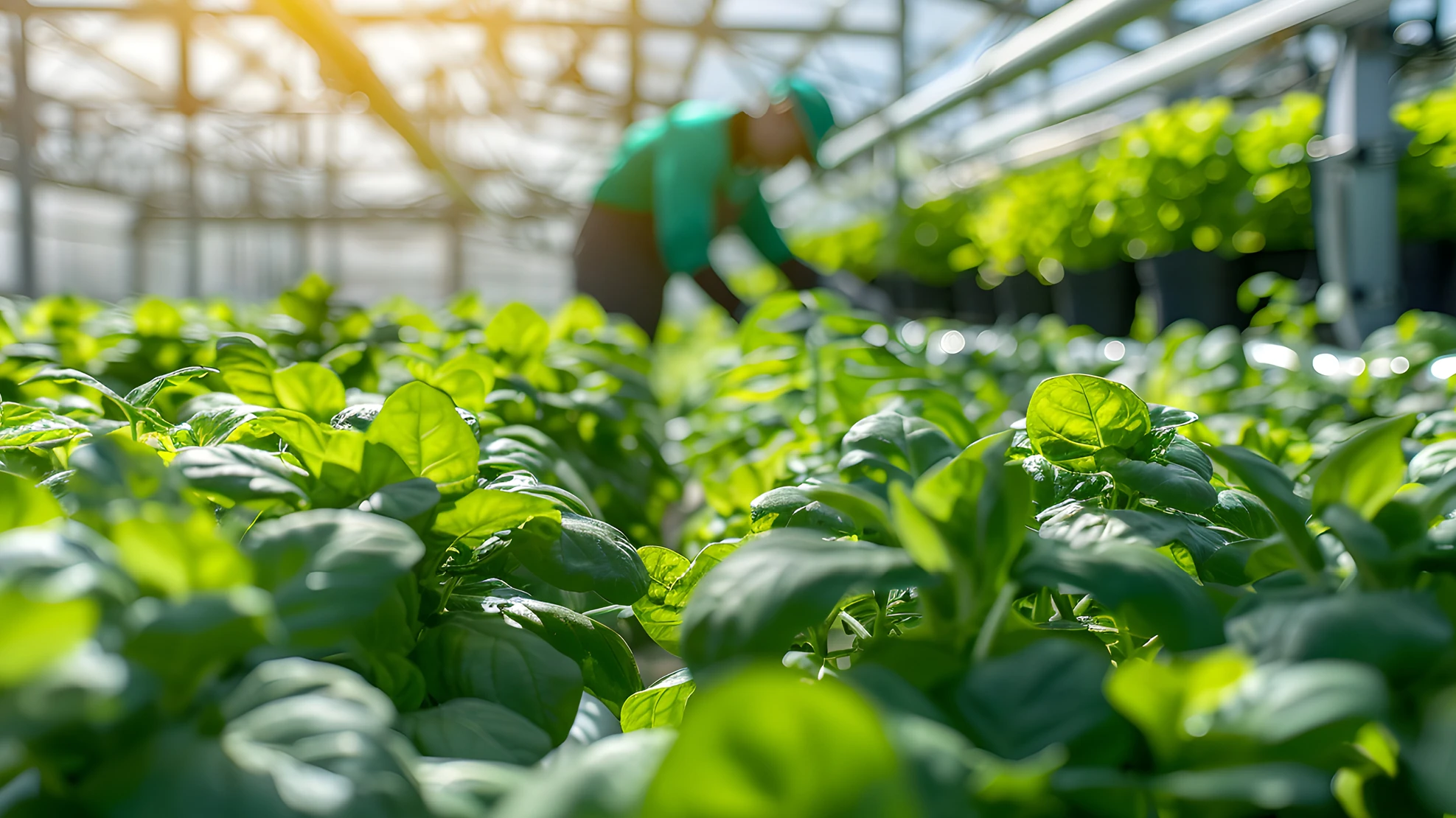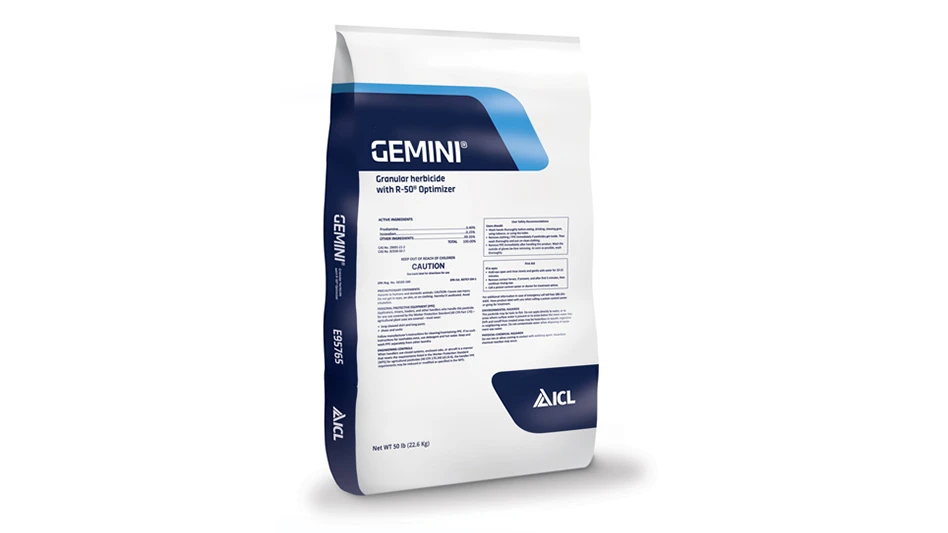 The marigold on the left, grown in 1P Mix, was fed with a water-soluble fertilizer. The one on the right was grown in 1P Mix incorporated with Osmocote Start, a six-week controlled-release fertilizer.Growing media has three basic purposes:
The marigold on the left, grown in 1P Mix, was fed with a water-soluble fertilizer. The one on the right was grown in 1P Mix incorporated with Osmocote Start, a six-week controlled-release fertilizer.Growing media has three basic purposes:
- Provide physical support for the plant.
- Provide adequate air space to support root respiration.
- Provide sufficient moisture to hydrate the roots and support evapotranspiration.
But the medium is in intimate contact with plants’ root systems throughout the life of the crop. This makes the medium an ideal conduit to provide additives that can protect plants, improve growth, enhance shelf life and reduce crop shrinkage. Growers can improve crop performance by incorporating additives to their media.
1. Limestone
Media pH is important for good growth, and each crop has an ideal pH range. Dolomitic limestone is the most commonly used limestone, but calcitic limestone can also be used.
Very fine limestones are used for greenhouse crops because they can influence the medium pH for a short period of time. Coarser limestones are used for longer-term crops.
A recent trend has been to blend together fine and coarse limestone particles in growing mixes to provide both short- and long-term benefits. The rate of limestone incorporation is dependent upon the buffering acidity of the medium, the alkalinity of the irrigation water and the desired pH required by the crop.
2. Wetting agents
Wetting agents are compounds that reduce the hydrophobic properties of media components, such as peat and pine bark. When properly incorporated, these agents overcome the surface tension that repels water droplets and allows for uniform wetting and saturation of a growing mix. This process is critical to produce a uniform crop.
Originally it was thought that wetting agents would last for the entire crop production cycle. However, research has shown the agents’ benefits do not persist. In fact, a wetting agent drench just prior to shipping can improve the saturation of the root ball and can increase available water to the plant at the retail level.
3. Water-soluble fertilizers
The original Cornell University peat-lite mixes included water-soluble fertilizers. The rationale was to have nutrients readily available for seedlings and young transplants. Young plants have small, limited root systems and do not absorb nutrients readily when fertilizer is supplied in the irrigation water.
These incorporated fertilizers can be complete fertilizers or combinations of materials including gypsum, minor elements or individual macro-nutrient fertilizer salts. A disadvantage of using water-soluble fertilizers is the nutrients can be readily leached and lost through heavy rains or a thorough irrigation before the roots have a chance to take them up.
4. Calcined clays
Growers who remember using pasteurized mineral soils in their growing media appreciate the buffering capabilities of clay fractions. Small quantities of calcined clay can mimic these properties. Calcined clays are sterile and screened to specific sizes, thus eliminating concerns for weeds and diseases.
5. Controlled-release fertilizers
Nursery growers have incorporated controlled-release fertilizers (CRFs) into container growing mixes for nearly 40 years. Greenhouse growers have been more reluctant to use them because of concerns of “losing control” of their crops.
New technologies and more formulations have made CRFs more practical and beneficial to the ornamental plant industry. Many crops are produced using CRFs as the sole source of nutrition.
In the future, many growers will likely use CRFs at reduced rates and supplement with liquid feed. This will allow growers to maintain “control” over their crops and will provide a carry-over effect at the retail and consumer level, helping to reduce crop shrinkage and increase consumer satisfaction.
6. Biological organisms
During the past 40 years, significant progress has been made in developing micro-organisms that are beneficial to plants. These benefits may enhance plant growth under stressful conditions or suppress soil-borne diseases that attack plant roots.
Micro-organisms survive in growing media in a dormant stage and become active in the presence of plant root activity. These micro-organisms colonize the surfaces of the plant roots in a symbiotic relationship. Recent advances in manufacturing processes are making these products more available to the ornamentals industry.
There are several control mechanisms involved with these micro-organisms:
- They can physically protect the root surface.
- They can inhibit or actually kill pathogens near the roots.
- They can trigger a metabolic response within the plant to fend off disease.
7. Water-holding polymers
Water-holding polymers are small crystals that have the capacity to absorb many times their weight in water when incorporated into a growing mix. Their water-holding capacity can be a valuable attribute in reducing water stress in the later production stages and reduce shrinkage at the retail level. In theory, this is a very attractive option for growers.
When water is added to these polymers, the crystals absorb the water and form a gel. The polymers take up air space in the growing medium. Care must be taken to ensure good air/water relations are maintained in the medium. It’s uncertain how much of this “held water” becomes available for plant use.
An important product for growers of organic products is granulated organic fertilizer. It’s more economical to incorporate these than to apply liquid formulations or rely upon top-dressing applications.
Any grower who has worked with odoriferous liquid formulations or experienced the cost of them will appreciate the ease of incorporating the granulated fertilizers into the growing medium.
The granulated fertilizers are often made of manure products and/or composts. The key with granulated manure products is to identify an incorporation rate that provides sufficient nutrients yet avoids high levels of plant-damaging soluble salts.
9. Active ingredients
Fungicides, insecticides and herbicides have been formulated as granular products and can be added to growing media. In this granular form, the chemicals can be uniformly incorporated and provide prolonged protection for the crop.
The fungicides and insecticides are in intimate contact with the roots for easy absorption by the plants. These products can help reduce re-entry requirements and the need for greenhouse employees to wear personal protection equipment.
Determining value
Incorporating any of the above additives can increase growing media costs, so it’s important for growers to be efficient and consistent. Value-added components must be economical and offer an adequate return on investment. The value may be measured by reduced labor needs, more uniform crops, better shelf life and optimal consumer satisfaction. If you’re not considering incorporating some of the above additives, then you are not receiving full value from your growing medium.
Hugh Poole is director of technical services, Jamie Gibson is director of research and development, and Bob Steinkamp and Michael Tilley are technical services managers, Conrad Fafard Inc., Technical Services, (864) 224-7989, Ext. 2382; jamie.gibson@fafard.com; www.fafard.com.

Explore the October 2010 Issue
Check out more from this issue and find your next story to read.
Latest from Greenhouse Management
- Flexible fungicides
- Super Charged Moon Juice from Moon Valley Nurseries now available nationally
- 2025 Proven Winners Horticulture Scholarship applications now open
- How to improve inventory and shipping management in the greenhouse
- Leading Women of Horticulture: Anna Ball, Ball Hort, and Terri McEnaney, Bailey Nurseries
- GM CEA HERB Part 2: A guide to increasing the sowing density of culinary herbs
- GM CEA HERB Part 1: Best practices for producing culinary herbs in controlled environments
- USDA fires experts on invasive pests, including Asian citrus psyllid, chilli thrips







